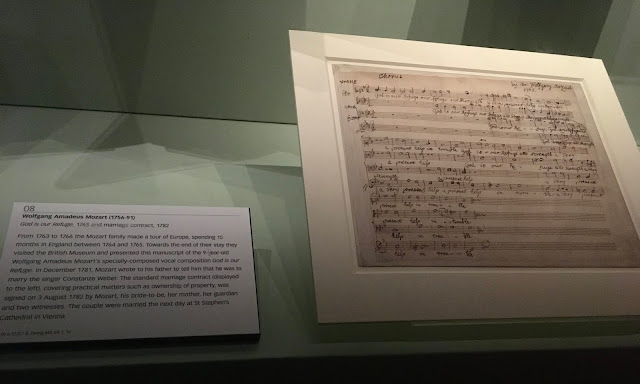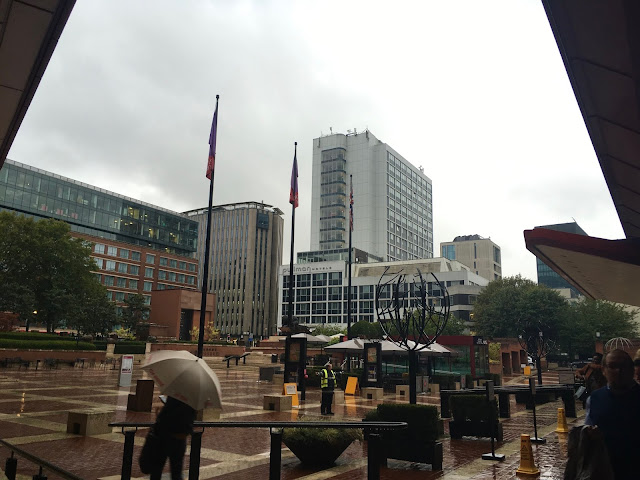The British Library was our first stop in London. We came right from the train station and the staff was kind enough to hold our bags.
In addition to the staggering collection of books, The British Library also has a room where rare and precious documents are on display. This was an absolute treat and one of the highlights of our trip. The little room came with an enormous cultural impact.
An illustrated book of herbal plants from northeast Italy from the 15th century.
A Latin translation of an Arabic book of optics from the late 14th century.
The Tale of Panji and A History of The Javanese Courts, both from the early 1800’s.
The strikingly illustrated Javanese wuku calendar, 1738.
Exploring The Stars, 1485, featuring beautiful woodcuts of constellations.
Salve Regina, 1465, with woodcut pictures colored by hand.
The Gutenberg Bible, from the mid 1400’s. One of the first books made with moveable type; an invention that was able to produce books quickly and made them more affordable and accessible. One of the books that changed the world produced by an invention that changed the world as well. It brought tears to my eyes.
The book from Korea dated 1442 was made with a moveable-type font as well.
Buddhist Printed Prayer Sheet, 10th century.
Engravings of The Virgin and Child, 16th or 17th century. Since 1580 Jesuit missionaries had brought European engravings to the Mughal court. Mughal artists were commissioned to illustrate Christian subjects. This engraving depicts the flight into Egypt.
Two Pigeons, India, 1630-33.
The Percy Psalter and Percy Hours, late 13th century. Originally these books formed a single volume until a book dealer split them. The British Library acquired both books and now they sit together after being separated for almost 200 years.
Manuscript Book of Hours, 1500, featuring a vibrant illustration of the Annunciation.
The Southwark Hours, late 14th century, with beautifully designed embellishments framing the illustration and text.
Carmina Regis: Address of the City of Prato to Robert of Anjou, 1335. Intended as a gift for Robert of Anjou it includes many references to classical mythology.
Rani Jindan’s Prayer Book, India, 1828-30. The bold illustrations beautifully complimented by the Gurmukhi script written in white ink on a black background.
Gospel Lectionary of Sainte-Chapelle, late 13th century.
The Four Gospels, Egypt, early 18th century. Written in both Coptic and Arabic.
The Four Gospels in Ethiopic, 17th century. I had known about Ethiopia’s long Christian history but I had never before seen a bible from Ethiopia. It was absolutely breathtaking.
Armenian Prayer Scroll, 1655.
Codex Alexandrinus, Eastern Mediterranean, 5th century. One of the three earliest manuscripts to contain the entire bible (both Old and New Testament) in Greek.
Mamluk Qur’an, Egypt, 14th century. Absolutely astonishing color and detail.
The Collected Works of Christine de Pizan (The Book of the Queen), Paris, 1410-14. Christine de Pizan, thought to be the first professional female author in Europe, defended the moral and intellectual character of women. This book is the largest collection of her work.
King Arthur, 12th century.
Wolfgang Amadeus Mozart, this unusual document features his composition for God is our Refuge (1765) and his marriage contract to singer Constanze Weber (1782).
Albrecht Durer, Nuremberg, 1512. This unassuming little book made my heart soar. My favorite artist Albrecht Durer making a quick sketch of some people fencing, another love of mine.
The many levels of The British Library.
A six story glass tower in the middle of the library holds The King’s Library; a collection amassed by King George III between 1763 and 1820.
Leaving the British Library and entering into the beautifully quintessential London weather.

































No comments:
Post a Comment